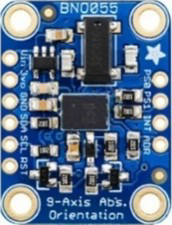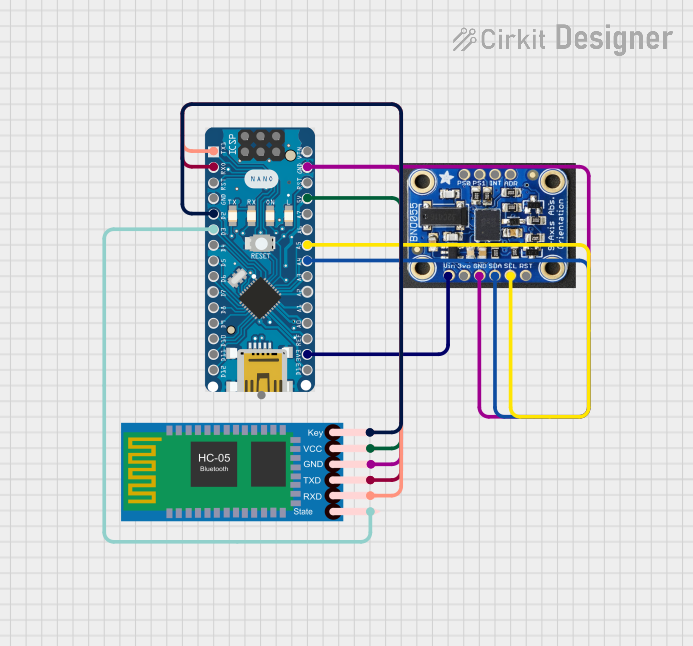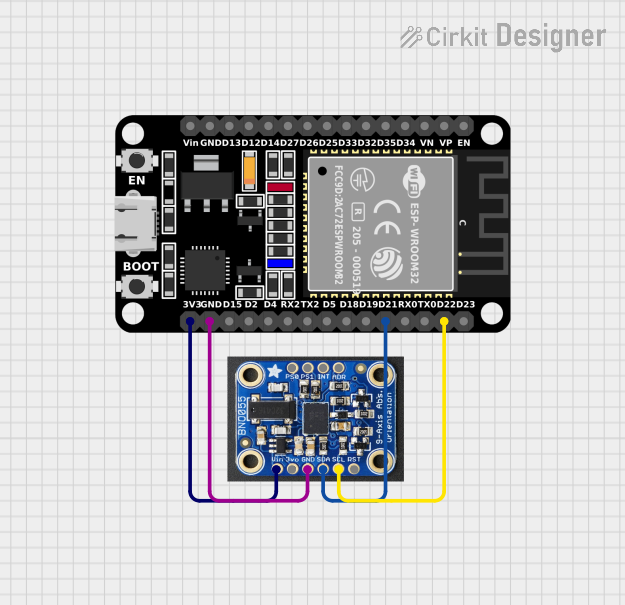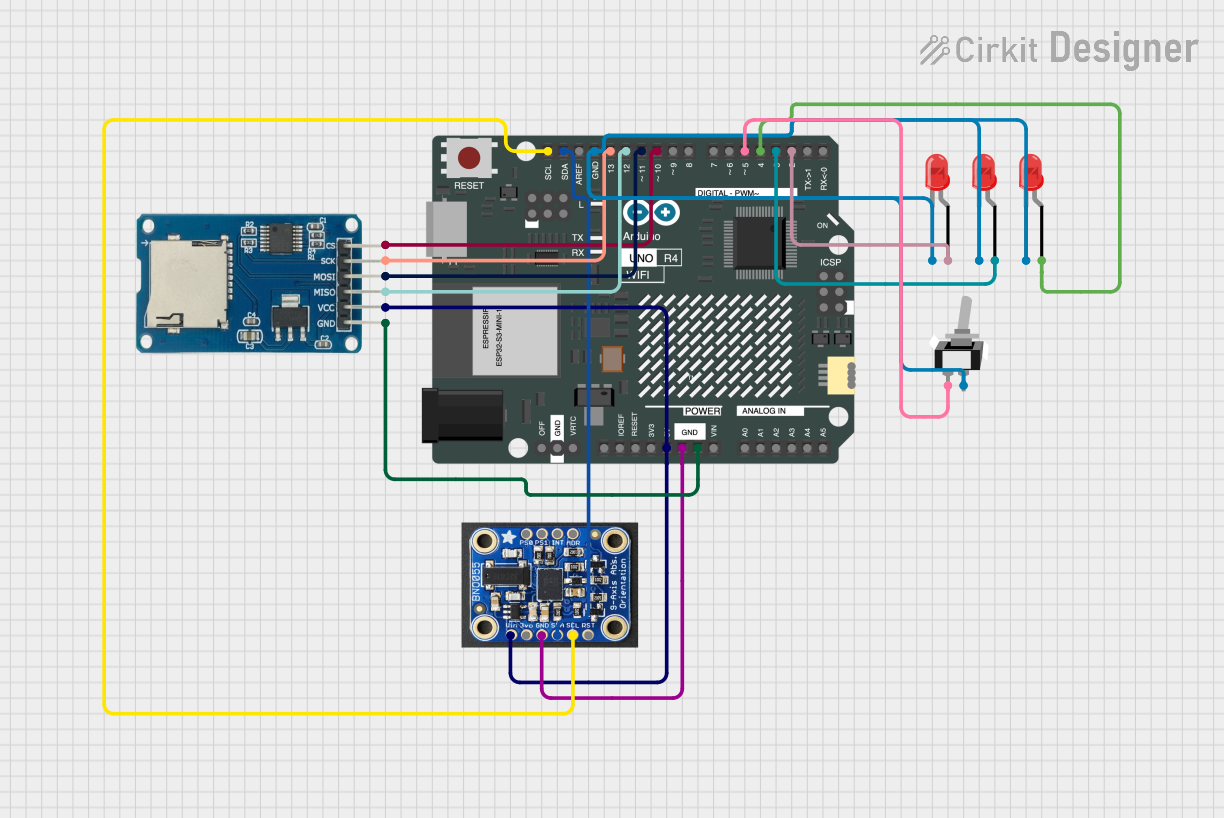
How to Use BNO055: Examples, Pinouts, and Specs

 Design with BNO055 in Cirkit Designer
Design with BNO055 in Cirkit DesignerIntroduction
The BNO055 is a 9-axis absolute orientation sensor that integrates a 3-axis accelerometer, a 3-axis gyroscope, and a 3-axis magnetometer into a single package. Unlike traditional sensors, the BNO055 features an onboard microcontroller that fuses raw sensor data to provide accurate orientation information in the form of Euler angles (pitch, roll, yaw) or quaternions. This eliminates the need for complex sensor fusion algorithms on the host microcontroller.
Explore Projects Built with BNO055

 Open Project in Cirkit Designer
Open Project in Cirkit Designer
 Open Project in Cirkit Designer
Open Project in Cirkit Designer
 Open Project in Cirkit Designer
Open Project in Cirkit Designer
 Open Project in Cirkit Designer
Open Project in Cirkit DesignerExplore Projects Built with BNO055

 Open Project in Cirkit Designer
Open Project in Cirkit Designer
 Open Project in Cirkit Designer
Open Project in Cirkit Designer
 Open Project in Cirkit Designer
Open Project in Cirkit Designer
 Open Project in Cirkit Designer
Open Project in Cirkit DesignerCommon Applications and Use Cases
- Robotics for precise motion tracking and navigation
- Drones for stable flight control and orientation sensing
- Virtual reality (VR) and augmented reality (AR) systems
- Wearable devices for activity tracking
- Industrial automation and human-machine interfaces
Technical Specifications
The BNO055 is a highly versatile sensor with the following key specifications:
| Parameter | Value |
|---|---|
| Operating Voltage | 2.4V to 3.6V |
| Communication Interfaces | I²C (default address: 0x28 or 0x29), UART |
| Power Consumption | 12 mA (typical in normal mode) |
| Operating Temperature Range | -40°C to +85°C |
| Output Data | Euler angles, quaternions, linear acceleration, gravity |
| Sensor Fusion Modes | 9-axis fusion, accelerometer-only, gyroscope-only, etc. |
| Dimensions | 3.8 mm x 5.2 mm x 1.1 mm |
Pin Configuration and Descriptions
The BNO055 is typically available in a breakout board format. Below is the pinout for a common breakout board:
| Pin Name | Description |
|---|---|
| VIN | Power supply input (3.3V or 5V, depending on the breakout board design) |
| GND | Ground connection |
| SDA | I²C data line |
| SCL | I²C clock line |
| PS0 | Protocol selection pin (connect to GND for I²C, or VCC for UART) |
| PS1 | Protocol selection pin (used in combination with PS0 for protocol selection) |
| RST | Reset pin (active low) |
| INT | Interrupt pin (used for event notifications) |
Usage Instructions
How to Use the BNO055 in a Circuit
- Power the Sensor: Connect the VIN pin to a 3.3V or 5V power source (depending on the breakout board) and GND to ground.
- Select Communication Protocol:
- For I²C, connect PS0 to GND and PS1 to GND. Connect SDA and SCL to the corresponding I²C pins on your microcontroller.
- For UART, connect PS0 to VCC and PS1 to GND. Connect the TX and RX pins to the UART pins on your microcontroller.
- Pull-Up Resistors: If using I²C, ensure that SDA and SCL lines have pull-up resistors (typically 4.7kΩ).
- Initialize the Sensor: Use the appropriate library or write custom code to initialize the BNO055 and configure its operating mode.
Important Considerations and Best Practices
- Power Supply: Ensure the sensor operates within its voltage range to avoid damage.
- Mounting Orientation: Mount the sensor securely and ensure it is aligned with the axes of your system for accurate readings.
- Calibration: Perform calibration for the accelerometer, gyroscope, and magnetometer to achieve optimal accuracy. The BNO055 provides built-in calibration routines.
- I²C Address: The default I²C address is 0x28. If multiple BNO055 sensors are used, you can change the address to 0x29 by pulling the ADR pin high.
Example Code for Arduino UNO
Below is an example of how to use the BNO055 with an Arduino UNO via I²C:
#include <Wire.h>
#include <Adafruit_Sensor.h>
#include <Adafruit_BNO055.h>
// Create an instance of the BNO055 sensor
Adafruit_BNO055 bno = Adafruit_BNO055(55);
void setup() {
Serial.begin(9600);
// Initialize the BNO055 sensor
if (!bno.begin()) {
Serial.println("Error: BNO055 not detected. Check connections.");
while (1);
}
Serial.println("BNO055 initialized successfully!");
// Set the sensor to NDOF mode (9-axis sensor fusion)
bno.setMode(Adafruit_BNO055::OPERATION_MODE_NDOF);
delay(1000); // Allow time for initialization
}
void loop() {
// Get Euler angles (heading, roll, pitch)
sensors_event_t event;
bno.getEvent(&event);
Serial.print("Heading: ");
Serial.print(event.orientation.x);
Serial.print(" Roll: ");
Serial.print(event.orientation.y);
Serial.print(" Pitch: ");
Serial.println(event.orientation.z);
delay(500); // Delay for readability
}
Troubleshooting and FAQs
Common Issues and Solutions
Sensor Not Detected:
- Cause: Incorrect wiring or I²C address mismatch.
- Solution: Double-check the connections and ensure the correct I²C address is used in the code.
Inaccurate Readings:
- Cause: Sensor not calibrated or mounted improperly.
- Solution: Perform the calibration routine and ensure the sensor is securely mounted.
No Output or Freezing:
- Cause: Insufficient power supply or communication issues.
- Solution: Verify the power supply voltage and check the SDA/SCL connections.
Drifting Orientation:
- Cause: Magnetometer interference or gyroscope drift.
- Solution: Avoid placing the sensor near magnetic fields and recalibrate if necessary.
FAQs
Q: Can the BNO055 be used with 5V logic microcontrollers?
A: Yes, most breakout boards include level shifters to support 5V logic. Check your specific board's documentation.Q: How do I know if the sensor is calibrated?
A: The BNO055 provides calibration status for each sensor. Use thegetCalibration()function in the Adafruit library to check the status.Q: Can I use the BNO055 with SPI?
A: No, the BNO055 supports only I²C and UART communication protocols.Q: What is the maximum update rate of the BNO055?
A: The BNO055 can output data at up to 100 Hz in fusion mode.
By following this documentation, you can effectively integrate the BNO055 into your projects and achieve accurate orientation sensing.